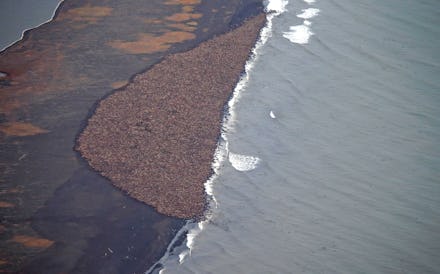One Photo Sums Up Why You Should Care About Climate Change

The news: If the dismal amount of attention climate change currently receives continues, we may soon find ourselves closer to that Beatles song than we ever imagined.
According to the National Oceanic and Atmospheric Administration, an estimated 35,000 walruses have come ashore in northwest Alaska. This isn't normal: The tusked creatures normally hang out on Arctic sea ice, not these beaches. However, the amount of sea ice has declined considerably because of the warming climate, meaning thousands of walruses are now flocking to a foreign locale.
"It's another remarkable sign of the dramatic environmental conditions changing as the result of sea ice loss," Margaret Williams, managing director of the World Wildlife Fund's Arctic program, told the Associated Press. "The walruses are telling us what the polar bears have told us and what many indigenous people have told us in the high Arctic, and that is that the Arctic environment is changing extremely rapidly and it is time for the rest of the world to take notice."
She's not kidding. This walrus gathering is recent, but it's certainly not the first. As Vox points out, in 2010, about 20,000 walruses made landfall near Point Lay, Alaska; in 2011, almost 30,000 showed up.
As Williams noted, polar bears have previously been the go-to symbol for quickly dissipating sea ice and climate change as a whole. The image of the majestic creature stranded on melting ice is one that has endured — and plucked more than a few heart strings — and it looks as though walruses may be up next.
It's still unclear whether walruses will be able to adapt to human-induced climate change. Unlike seals, they can't swim indefinitely, prompting the need for a place to rest. However, the shores of Alaska present different challenges than sea ice does — young walruses, the United States Geological Survey noted, are at risk of dying due to trampling onshore, and feeding requires more energy because the resting spots aren't as close to food sources.
In short, this is bad. While our situation isn't as visibly dire as that of our walrus friends, we're rapidly approaching a similar fate. Even if we can't picture ourselves in that position — that trusty human capability to believe in our own indefatigability is remarkably strong — at least think of the walruses ... and the polar bears, sea turtles, giant pandas, orangutans, and, oh, the 52% of the wildlife population that's disappeared in the last 40 years.